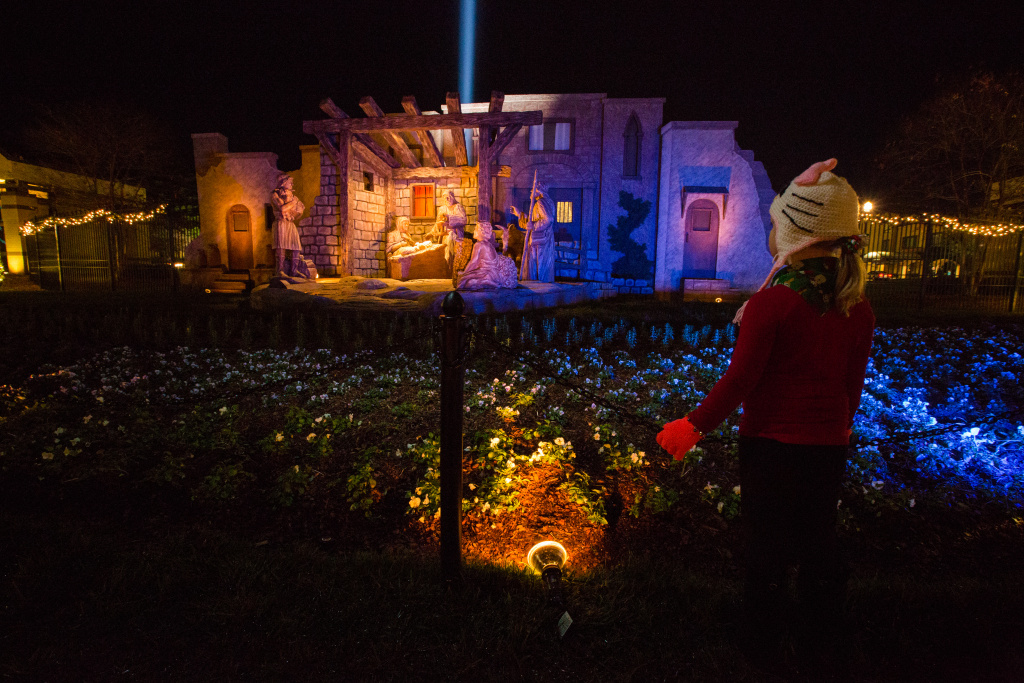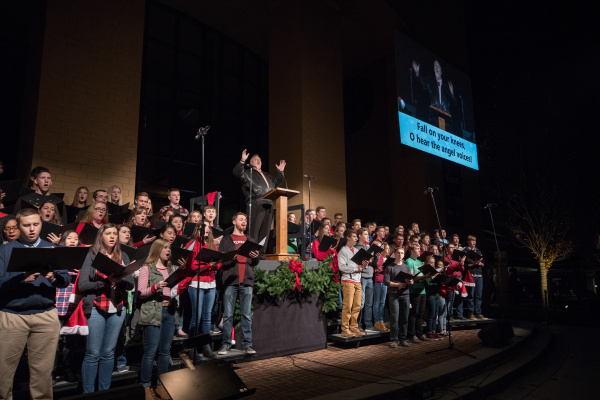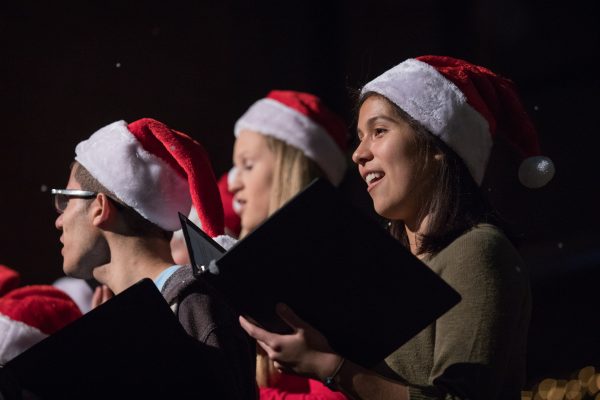Every December since 2011, the towering beam of light accompanying The Crèche, a tableau scene of Christ’s birth, has beckoned motorists and pedestrians to the main entrance of Bob Jones University.
“One night we were driving on Wade Hampton Boulevard, heading home from downtown, and saw this spotlight,” says Matt Wagner of Greer, South Carolina, “so, of course, we had to see what it was about. That was many years ago when our daughter was 5, but I’m glad we stopped. We’ve been back every year, about once a week in December actually. It’s important for our daughter, who’s 12 now, and all of us.”
Doug Young has witnessed and heard similar impactful and poignant stories about the larger-than-life Nativity scene that features the historic principals he sculpted from large, solid blocks of expanded polystyrene.
A depiction of the bustling town of Bethlehem, which reaches 21 feet at its peak, provides the backdrop and the open-air barn is 14 feet tall.
The vertical spotlight enhances the dramatic effect of the Biblical scene. Softer lighting highlights the facial features of the shepherds, who gaze upon the Christ child lying in the manger, Joseph holding a lantern as he warily looks at the growing number of curious visitors, and Mary’s contemplative expression.
“You see the beam of light, which was the idea of Rich Streeter from BJU, then the barn and you see the shepherds and your eyes follow to the child,” Young says. “I was trying to get as much attention on the Christ child and not on the shepherds.
“(The scene’s) not pretty and gold and jewels and elaborate because it wasn’t that. The reason I wanted that barn outside the city is everything going on, the bustle and they are outside. The activity is going on all around and here Christ is outside. It’s a historical event. I think we do ourselves an injustice by saying it’s religious art because it’s also historic. It was an actual event.
“I think the more realistic we can make something, we can communicate the event was real.”
Redemption is the underpinning
Communicating God’s plan of redemption, which was put in motion with Jesus’ birth in a humble setting, “is the idea,” according to Young.
“What is most satisfying is when people are standing there and they go ‘ahhh’ or are silent because it touches them. It speaks to them,” says Young, a BJU alumnus and resident of Taylors, South Carolina. “That’s why actors perform; not just so people can say ‘he’s a great actor’ but because they want to touch the audience somehow. I love when children and even adults just stand there because I know they’re thinking about the story.”
The Christmas story has always been among the most beloved to Young, who’s crafted bronze outdoor statues such as Shoeless Joe Jackson and Water Blessing in downtown Greenville and The Patriot at J.L. Mann Academy among his more notable.
When the opportunity arose to sculpt The Crèche, he immediately cleared out a large workspace in his Taylors studio. Once completed, the pieces joined the barn and backdrop, which was created by the BJU stage crew, on the stage at Rodeheaver Auditorium for the initial assessment.
“I looked at it and thought ‘this is huge,’ ” Young says. “The figures are about 6 or 7 feet tall and a bit heftier because I didn’t want them to get lost. When they got it out front (of campus), arranged everything, it was OK. It fit just right.”
The focus is Christmas
The Nativity, taken from the Latin nativus, which means “arisen by birth,” is one of the most recognizable symbols of Christmas. Saint Francis of Assisi is credited with creating the first Nativity scene in 1223 to cultivate the true meaning of Christmas and worship of Jesus Christ.
The evocative depiction at the main entrance on campus, which contains seven pieces inside the barn, has been heralded since its unveiling seven years ago. Thousands visit each year, with many, such as Wagner, bringing out-of-town family and friends to campus.
“The people, they’re so realistic,” Olivia Smith remarks to Young, who had engaged her family in conversation in front of the nativity scene November 30 following the annual University Carol Sing and Lighting Ceremony.
A broad smile flashes across the artist’s face. The Nativity scene is part of culture and art internationally, but above all, it’s a sign of faith in God, who came to live in our midst.
“It’s a success if it communicates something, if people think and talk about it. And I don’t mean talk about the work but the meaning,” Young says. “The focus is Christmas.”








